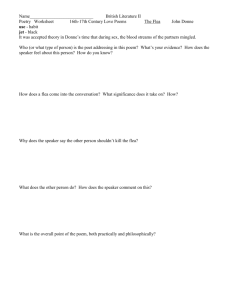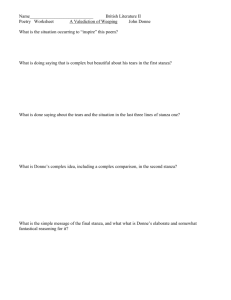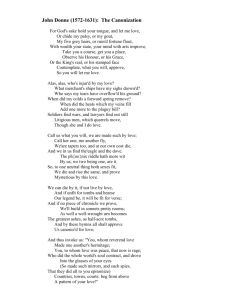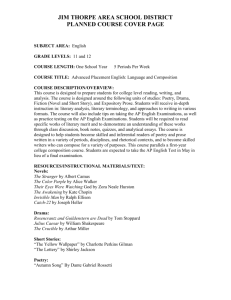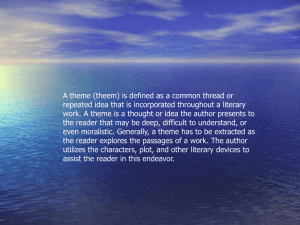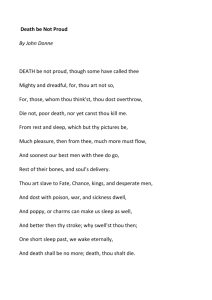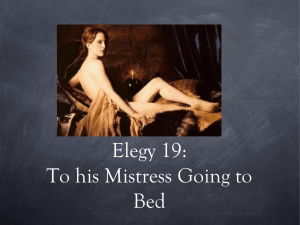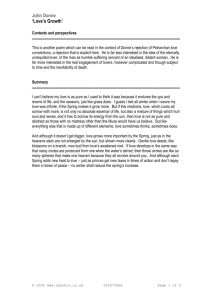IAA Q37 séance du 21 octobre John Donne HOLY SONNETS.
advertisement
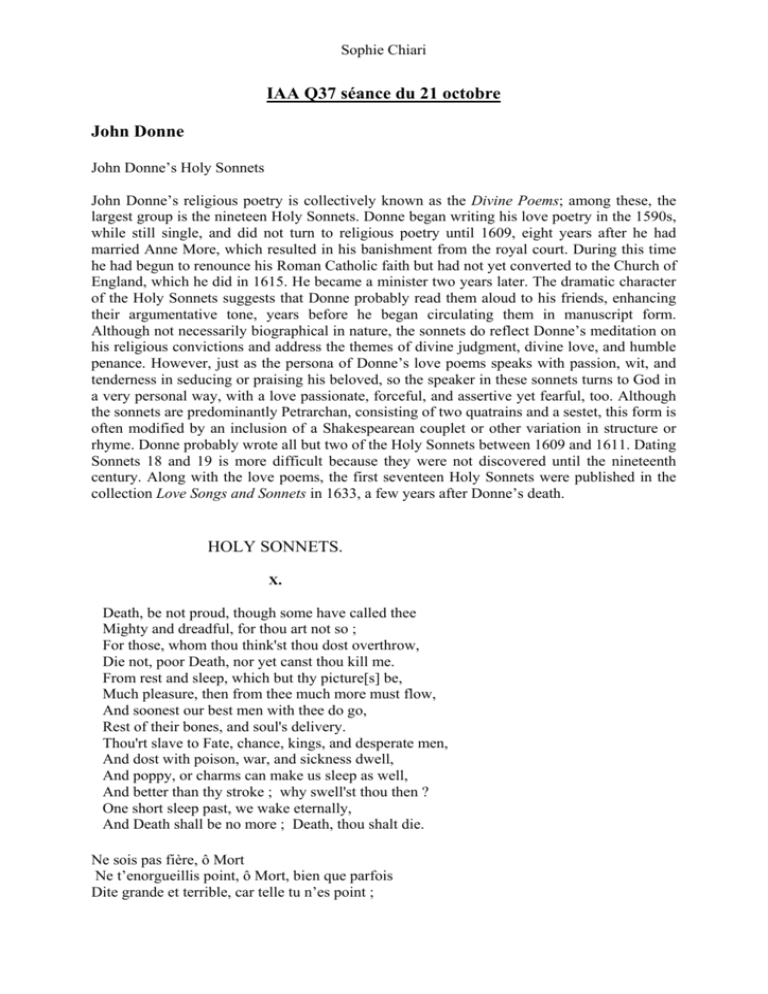
Sophie Chiari IAA Q37 séance du 21 octobre John Donne John Donne’s Holy Sonnets John Donne’s religious poetry is collectively known as the Divine Poems; among these, the largest group is the nineteen Holy Sonnets. Donne began writing his love poetry in the 1590s, while still single, and did not turn to religious poetry until 1609, eight years after he had married Anne More, which resulted in his banishment from the royal court. During this time he had begun to renounce his Roman Catholic faith but had not yet converted to the Church of England, which he did in 1615. He became a minister two years later. The dramatic character of the Holy Sonnets suggests that Donne probably read them aloud to his friends, enhancing their argumentative tone, years before he began circulating them in manuscript form. Although not necessarily biographical in nature, the sonnets do reflect Donne’s meditation on his religious convictions and address the themes of divine judgment, divine love, and humble penance. However, just as the persona of Donne’s love poems speaks with passion, wit, and tenderness in seducing or praising his beloved, so the speaker in these sonnets turns to God in a very personal way, with a love passionate, forceful, and assertive yet fearful, too. Although the sonnets are predominantly Petrarchan, consisting of two quatrains and a sestet, this form is often modified by an inclusion of a Shakespearean couplet or other variation in structure or rhyme. Donne probably wrote all but two of the Holy Sonnets between 1609 and 1611. Dating Sonnets 18 and 19 is more difficult because they were not discovered until the nineteenth century. Along with the love poems, the first seventeen Holy Sonnets were published in the collection Love Songs and Sonnets in 1633, a few years after Donne’s death. HOLY SONNETS. X. Death, be not proud, though some have called thee Mighty and dreadful, for thou art not so ; For those, whom thou think'st thou dost overthrow, Die not, poor Death, nor yet canst thou kill me. From rest and sleep, which but thy picture[s] be, Much pleasure, then from thee much more must flow, And soonest our best men with thee do go, Rest of their bones, and soul's delivery. Thou'rt slave to Fate, chance, kings, and desperate men, And dost with poison, war, and sickness dwell, And poppy, or charms can make us sleep as well, And better than thy stroke ; why swell'st thou then ? One short sleep past, we wake eternally, And Death shall be no more ; Death, thou shalt die. Ne sois pas fière, ô Mort Ne t’enorgueillis point, ô Mort, bien que parfois Dite grande et terrible, car telle tu n’es point ; Sophie Chiari Ceux sur lesquels tu t’imagines triompher Ne meurent, pauvre Mort ; tu ne peux me tuer. Nous tirons du repos, du sommeil, tes images, Grand plaisir ; de toi-même en doit sortir bien plus ; Et nos meilleurs sont les premiers à te rejoindre – Tu soulages leurs os, tu délivres leurs âmes ! Tes maîtres sont : destin, hasard, rois, furieux ; Tu demeures avec poison, maladie, guerre ; Un charme, ou le pavot, peuvent nous endormir Autant, mieux que ton dard. Pourquoi donc tant d’orgueil ? Un somme, et nous nous éveillerons éternels ; Et la Mort ne sera plus ; Mort, tu mourras ! John DONNE. (Traduit par Louis Cazamian.) Exercice : proposez votre propre traduction du poème de John Donne, et comparez. Utilisez vous les rimes ? The sonnet is a mixture of the Italian and English sonnet forms, a rarity in the early 17th century when poets felt a greater necessity to adhere to the prescribed forms than do modern sonneteers. The octave has the conventional Italian rhyme scheme abbaabba. However the sestet is not what one would expect. The English (or Shakespearean) sonnet ordinarily begins with three quatrains each with its own alternating rhyme abab cdcd efef and concludes with a rhymed couplet gg.. The sestet of the Italian sonnethas its own unity and may rhyme cdecde or cdcdcd. This poem has a conventional Italian octave, then a third quatrain with the Italianate cddc rhyme scheme and an English closing couplet. Generally, the English sonnet progresses to a surprising turn (or volta) in the concluding couplet. The Italian sonnet makes its dramatic turn between opening octave and concluding sestet. Since lines 13 and 14 are not a rhymed couplet (often indented in the English form), they are less emphatic, less like a punch line. So we need to ask why in this poem Donne finds it most suitable to commingle the sonnet forms. Analysis The poet wishes to convey his message of eternal life and feels that people should not be afraid of dying, as there will still be, in his view, eternal life in heaven. He knows that everyone must die eventually, even, "our best men with thee do go". This is his basis for his acceptance of death and thereby defeating it. Donne's motivation for this poem stems from his religious background as he was a descendant of Saint Thomas Moore and was raised as a Roman Catholic, yet he still fuses his calculated thoughts with his feelings.Donne opens the poem with a defiant tone, indicating his stand against death. In his metaphysical conceits, the poet developes a lengthy, complex image to express his involved but controlled view of a person, object or feeling, in this case death being compared to a person. The movement is appropriate as the defiant tone in the beginning lends itself to the fast pace of the first four Sophie Chiari lines. A steady pace is then developed while Donne explains his point of view. An elegy is a classical form of poetry mixed with modern influences and this emphasises Donne's own form of writing and what he tries to convey in the poem, mixing feelings with calculated thoughts. Being a metaphysical poet, Donne usually used irregular rhythms, however, in this poem he uses bound verse and has a metrical pattern. He too is cynical and states; "Die not, poor death" and humiliates death. By making slight variations in the rhythm, the poet gives the lines a melody. He uses extremely emotive diction, such as "Mighty" and "dreadful" to incite feelings in the reader and to indicate that death is not these things. Enjambment is used to give many of the lines a free flowing affect and therefore create a faster pace when it is needed. The poet uses Iambic pentameter to create a rhythmical feeling within the poem. The use of diction is extravagant and is very important in the poem as it must describe the poet's feelings and, with difficulty, describe death. Donne uses realistic language so as to appeal to the masses. The poet succeeds in conveying his emotions using expressive diction, questioning the reader's emotions and thoughts on death and thereby creating insight in the readers mind. Donne personifies Fate and Chance to indicate they too are above dying. Death, commonly viewed as an all-powerful force against life, is otherwise described in John Donne's Holy Sonnet 10. As found in any English Sonnet, there is a rhyme scheme and a standard meter. Although the standard meter is iambic pentameter, as in most English Sonnets, the rhyme scheme differs a little from the usual, consisting of ABBA ABBA CDDC AE. Sonnets convey various thoughts and feelings to the reader through the different moods set by the author. In this case the speaker having to confront Death and defeat it, sets the mood. Throughout existence, there have been many theories regarding exactly what role Death plays in the lives of those who experience it. Some think Death is the ultimate controller of all living things, while others believe it is nothing more than the act of dying once your time has come. Donne, on the other hand, has his own philosophy. The entire Sonnet, Donne speaks directly to Death. Without fate nothing could be determined, therefore, our fate is truthfully what controls our lives and deaths. In lines one and two Donne says "Death, be not proud, though some have called thee, Mighty and dreadful thou art not so. Although we tell Death it does not control what our destiny is, we still recognize that eventually all of us will get there one way or another as stated in lines seven and eight, "And soonest our best men with thee do go, Rest of their bones, and soul's delivery. Dreams can only offer so much, as compared to eternal happiness will never ceases to give tranquility. " All of us will end up meeting Death; nevertheless it will not come for us during our lifetime, it will only watch from a distance, until called again. When Death becomes a slave it is because it will benefit from who will die, but doesn't have the power to kill. It decides when our time has been completed on this earth, and then comes Death to take us away. Death is shown a sense of insecurity in line three when the speaker says, "For those whom thou think'st thou dost overthrow, die not, poor Death, nor yet canst thou kill me. He gives Death life, and therefore makes it mortal, exposing it to pain, torment and eventually defeat. In line nine, the speaker goes against that to say that Death is a slave to fate, chance and us. Next, in line 10 he says "And dost with poison, war" and sickness dwell;" Therefore, not only is Death a slave, but it is also dependent on people in order to survive. " By referring to Death as a person, he makes it easier for the reader to bring Death down to a level of a weakness and venerability, allowing us to examine it to see what Death really is. " Donne is telling Death that all those who it think it killed it really didn't, and that it cant kill him, again proving that Death is not what takes lives but what delivers them. Sophie Chiari John Donne addresses Death as one would speak to a foe, harassing employee, or even an annoying bully who is too weak and without power to deliver his/her threats. Donne tells Death that he should not be so arrogantly proud even though some have made him think he is mighty and one to be feared. He points out to Death that he is far from being any of those things. He goes on to tell Death that even though he thinks he succeeded in overthrowing people. They are the ones who deliver their souls and who rest their bones even when death may not be ready for them. So it is Death that is a slave to fate, accidents, suicides, war, and sickness. Death must dwell with them and must also cease when these men die. Donne mocking Death says that even "poppy and charms" can provide a better sleep because Death is just a weakling. Donne points out that sleep which is the first death is short and one wakes to live for eternity. Thus Death is defeated and will no longer be. So Donne tells death that he shouldn't puff up with pride for it is Death that will face the real death. The first death for the believer is only a physical death; only the body is destroyed. This physical death serves as a portal to eternity. Donne drew from his priesthood studies the knowledge of the afterlife. Through his writings he was able to make death seem less threatening to himself and to the people of his time. After all, who has not questioned his/her existence after death? People are curious and tend to fear the unknown. Donne ends his admonishment very boldly: "Death thou shall die." The reader can sense that death is truly defeated forever more. There is some satisfaction in reading these words even if just for the moment. Anxious ones can return every now and then to the Scriptures and to "Death be not Proud" to find peace and encouragement.

